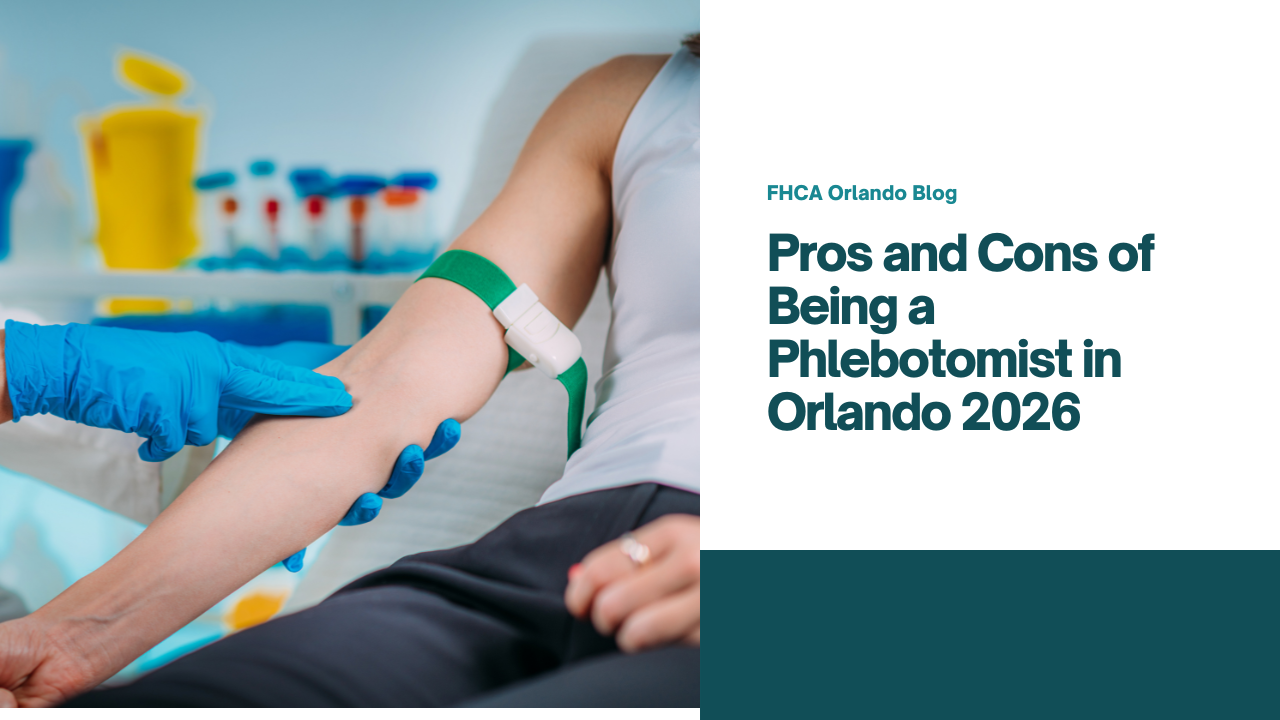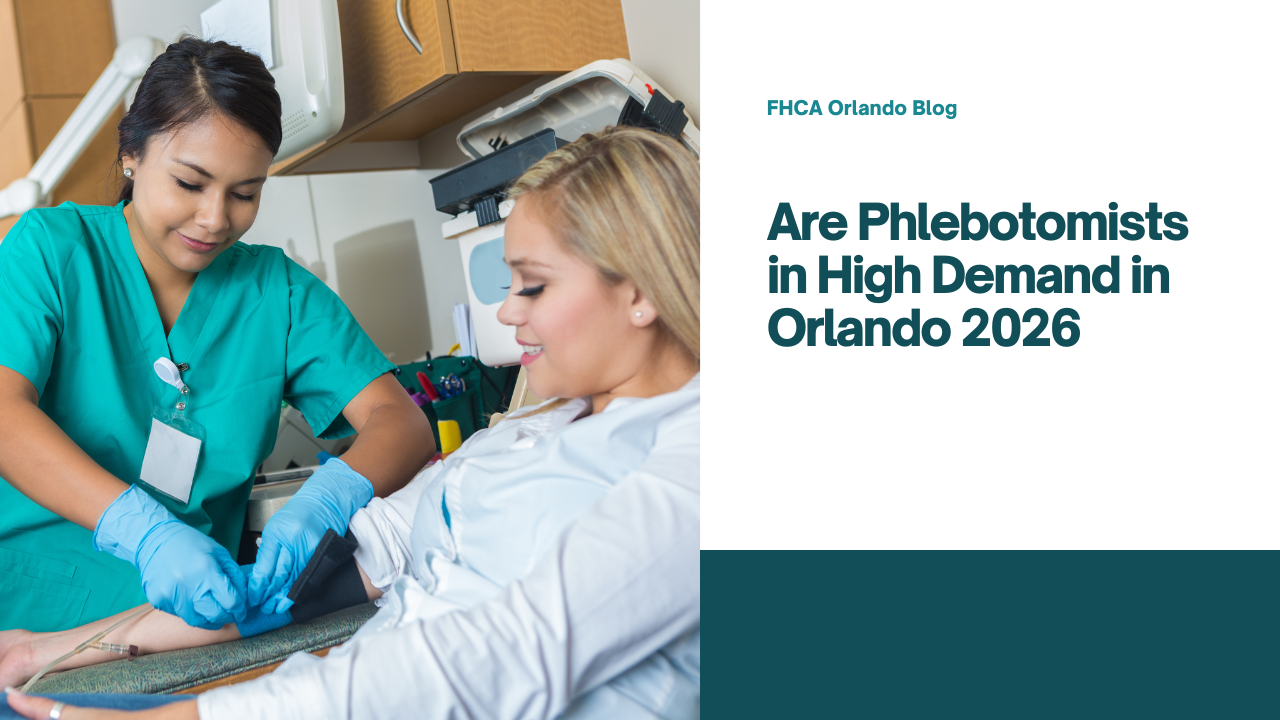Steps to Become a Medical Assistant
Aug 13, 2025
Becoming a medical assistant usually starts with earning a high school diploma or GED. From there, candidates complete a medical assistant program Orlando that offers both classroom instruction and hands-on clinical training.
After finishing their education, most take a national certification exam to demonstrate their skills. These steps prepare individuals to enter the healthcare field and support patient care effectively.
Table of contents
- Step-by-step process to become a medical assistant
- Inside the FHCA medical assistant program
- What happens after you become a medical assistant?
- FAQs about becoming a medical assistant
- Ready to take the first step toward your healthcare career?
Step-by-step process to become a medical assistant
Becoming a medical assistant involves completing education, training, and certification. These steps are designed to help you build the skills you need to succeed in a clinical environment and stand out to employers. However, if you're wondering whether can you become a medical assistant without school, there are alternative entry points into the field that you can explore.
Step 1 – Earn your high school diploma or GED
The first step is to complete a high school education, as most medical assistant programs require a diploma or GED for admission.
This foundational education equips students with essential reading, writing, and communication skills needed for their training. Those still completing their GED should consult with admissions to determine if they can begin the enrollment process early.
Step 2 – Enroll in a medical assistant training program
After earning a high school diploma or GED, the next step is to enroll in a certified medical assistant training program that equips you with the clinical and administrative skills needed for healthcare settings. FHCA’s training program in Florida offers a focused pathway toward certification and job readiness.
FHCA offers a career-focused program designed to prepare students for the demands of clinics, doctors’ offices, and urgent care centers. In fact, enrolling in a Medical Assistant Certification Program in Orlando is often the step that gives students the hands-on foundation needed to succeed in these fast-paced environments.
Step 3 – Complete classroom and hands-on training
During training, students acquire knowledge through both classroom instruction and practical, hands-on experience.
- Medical terminology
- Anatomy and physiology
- Front office procedures
- Basic patient care techniques
Additionally, students learn to take vital signs, assist with minor procedures, and operate electronic health records (EHR) software. These skills are essential for the diverse healthcare settings where medical assistants can work.
Step 4 – Pass a medical assistant certification exam
Upon completing their training, the final step for aspiring medical assistants in Florida is often to obtain certification. While Florida does not legally require medical assistants to be certified, many employers prefer or require certification as proof of competence and commitment to the profession.
Common certifications include:
- Certified Clinical Medical Assistant (CCMA)
- Registered Medical Assistant (RMA)
- Certified Medical Assistant (CMA)
Programs like FHCA prepare students to successfully pass these exams, boosting their confidence and employability. Earning certification can greatly improve job prospects in Florida’s competitive healthcare market.
Inside the FHCA medical assistant program
FHCA’s program provides comprehensive preparation for a healthcare career. With experienced instructors and hands-on clinical training, students develop the essential skills valued by employers in the medical field.
What you’ll learn during training
The curriculum combines clinical, administrative, and communication skills, preparing students to assist physicians.
- Assist physicians with exams
- Collect lab specimens
- Schedule patient appointments
- Handle insurance billing
Students also become familiar with patient confidentiality regulations and infection control protocols. This comprehensive training equips graduates to work confidently across a range of healthcare environments.
Hands-on experience and classroom instruction
The FHCA program places a strong emphasis on practical learning. Classroom instruction provides students with a clear understanding of the principles behind each task, while lab work and simulated environments demonstrate the proper techniques for execution.
Hands-on training is essential because it gives you a realistic sense of what it’s like to work in a healthcare facility. You’ll develop confidence using real tools and techniques, which prepare you for externships and future employment.
Preparing for certification
FHCA provides comprehensive support throughout the certification exam preparation process. Instructors familiarize students with the exam format, review essential topics, and provide practice questions to build confidence and readiness.
Earning certification enhances a candidate’s resume by demonstrating training and preparedness, broadening job prospects, and potentially increasing earning potential. For those uncertain about which exam to pursue, instructors and program advisors offer personalized guidance based on individual strengths and career goals.
What happens after you become a medical assistant?
Once students complete their training and earn certification, they are ready to enter the workforce. Understanding whether is medical assistant a healthcare provider can help clarify how your role fits into the broader healthcare system and what responsibilities you can expect. See also can PCT work as a medical assistant for insight on role overlap.
- Family practices
- Pediatric offices
- Urgent care centers
- Outpatient clinics
- Specialty practices (dermatology, cardiology, orthopedics)
They perform both clinical and administrative tasks, with daily responsibilities varying depending on the work environment.
Many medical assistants use this role as a stepping stone to advance within healthcare. With experience, they may pursue further training in alternative careers for nurses, office managers, or healthcare administrators.
FAQs about becoming a medical assistant
This section answers common questions about the path to becoming a medical assistant. From education requirements to certification and job outlook, these FAQs provide clear guidance for those considering a career in this growing healthcare field.
How long does it take to become a medical assistant?
Most programs can be completed in under a year. FHCA’s medical assistant program is designed to be efficient and focused, so you can finish quickly and enter the job market with confidence.
The timeline may vary slightly depending on class availability and your schedule.
Do I need to be certified to work?
In Florida, certification is not legally required to work as a medical assistant; however, many employers prefer or require it. Obtaining certification answers the question of how hard it is to become a medical assistant and demonstrates that candidates have met national standards and successfully passed a recognized exam.
Can you work on the steps to become a medical assistant?
Many students work part-time while completing their medical assistant training. FHCA offers flexible scheduling so you can balance work, study, and hands-on learning. Planning helps you succeed at every stage of your training process.
What happens after completing all the steps to become a medical assistant?
After completing your training and earning certification, you’ll be ready to enter the job market. FHCA helps you transition into the workforce with career support services, including job placement assistance, resume building, and interview prep.
Ready to take the first step toward your healthcare career?
FHCA offers the hands-on training, expert guidance, and certification prep you need to launch your healthcare career with confidence.
Whether you're just starting out or making a career shift, our Medical assistant program in Orlando gives you the skills to thrive.
Enroll now or reach out to our admissions team to take the first step toward your future.









